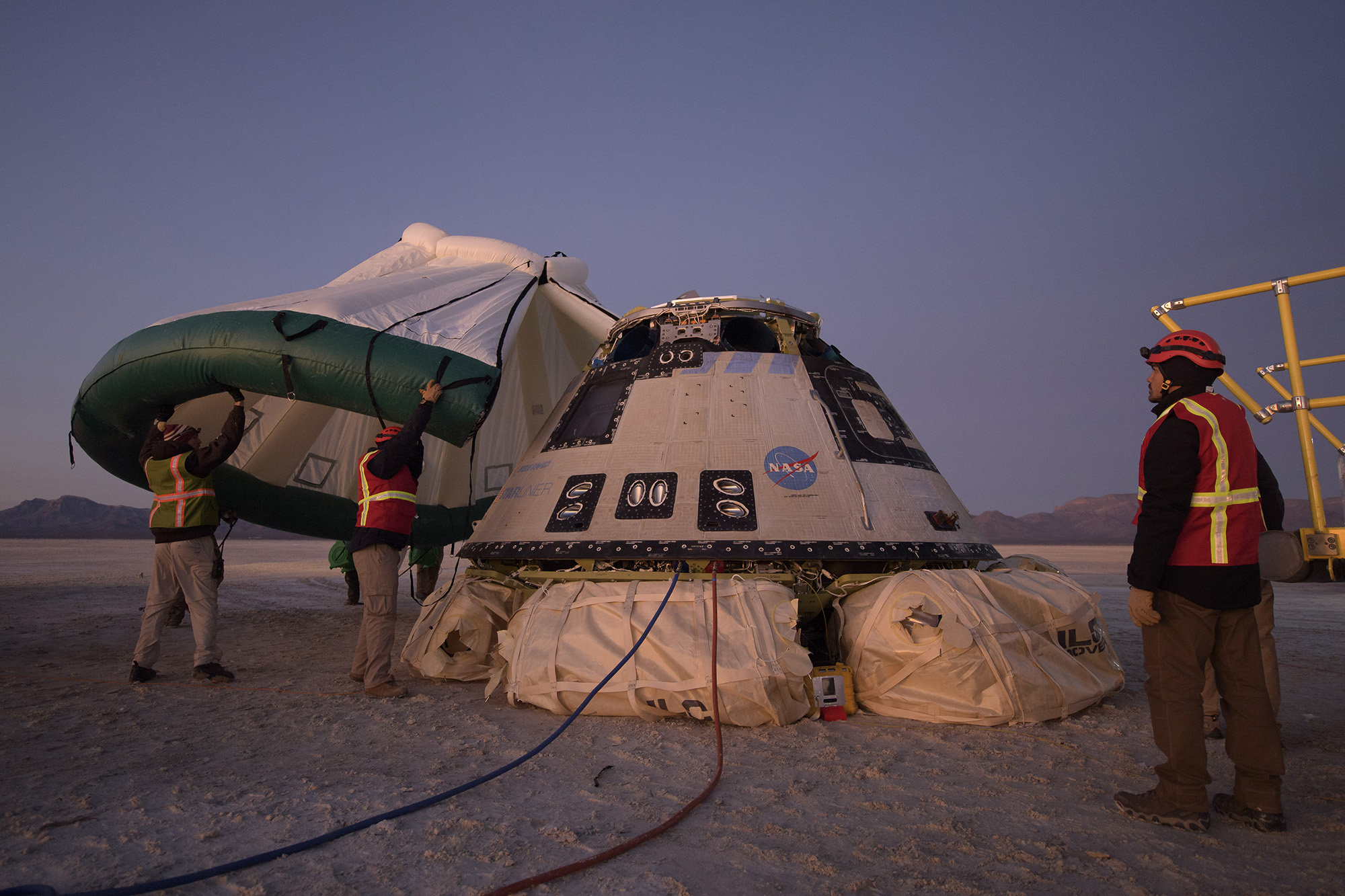

Veteran astronauts Sunita Williams and Barry Wilmore are currently docked at the International Space Station after facing multiple setbacks on their return journey in the Starliner spacecraft. NASA, along with the manufacturer Boeing, is conducting investigations and tests to ensure the safety and success of their return trip. However, the astronauts remain optimistic and confident that the spacecraft will bring them back to Earth without any problems.
Boeing Starliner Astronauts Await Return from Space Station After Setbacks
Background
NASA's Boeing Starliner spacecraft, designed to transport astronauts to the International Space Station (ISS), has faced several setbacks during its development and operational phases. The Starliner's first uncrewed flight test (OFT-1) in 2019 encountered software issues, preventing the spacecraft from reaching the ISS. The second uncrewed flight test (OFT-2) in 2021 was more successful, but still required unplanned maneuvering due to a thruster problem.
Current Situation
Despite the challenges, NASA and Boeing have launched the Starliner's first crewed mission, OFT-3, with veteran astronauts Sunita Williams and Barry Wilmore aboard. The spacecraft successfully docked with the ISS on August 9, 2023.
However, the return journey has hit some snags. A valve issue with the spacecraft's propulsion system has prevented the Starliner from undocking as planned. NASA and Boeing are working to resolve the problem while ensuring the safety of the astronauts.
FAQs
A definitive timeline for the astronauts' return has not yet been announced. NASA and Boeing are prioritizing the safety of the crew and are working diligently to resolve the technical issue.
The delay is due to a stuck valve in the Starliner's propulsion system. The valve is essential for maneuvering the spacecraft. NASA and Boeing engineers are working to understand the cause of the issue and develop a mitigation plan.
NASA officials have stated that the astronauts are safe and in good health. The Starliner spacecraft is equipped with life support systems that can sustain the crew for several months.
NASA and Boeing are conducting tests and investigations to determine the root cause of the valve issue. They are also working on alternative ways to maneuver the spacecraft.
The Starliner program has faced significant challenges, but it has also achieved milestones. The OFT-2 flight test was a success, and the OFT-3 mission has demonstrated the spacecraft's ability to transport astronauts to the ISS. However, the recent valve issue highlights the need for continued testing and refinement of the spacecraft.

In a recent family vlog, Indian celebrity couple Shoaib Ibrahim and Dipika Kakar shared their "natural" hair care routine for their son, using a homemade mask made with rice flour, flax seeds, and coconut oil. However, experts warn that what works for adults may not be suitable for babies, whose sensitive skin and scalp could react to the ingredients. While the ingredients may improve hair texture, they do not necessarily promote hair growth. Instead, a healthy diet and good scalp care are more important in maintaining healthy hair.

A recent consumer study has found multiple brands of soft contact lenses in the U.S. to contain "forever chemicals" that can be harmful to both the body and the environment. The study, conducted by the nonprofit organization Environmental Health Sciences, tested 18 varieties of popular contact lenses and found all of them to contain markers for PFAS. Brands such as Acuvue, Alcon, and CooperVision were among the list of affected products. This news serves as a cautionary lesson on the potential risks of overusing contact lenses.

On the birth anniversary of Dr. APJ Abdul Kalam, the ‘Missile Man’ of India, tributes pour in on social media celebrating his life, vision and impact. A visionary scientist, inspiring leader and true patriot, Dr. Kalam's humility, compassion and constant interaction with students continue to inspire generations. His tireless efforts in defense, science and youth empowerment have strengthened India's path towards self-reliance and his legacy continues to motivate young minds to dream big and work hard for the nation.

Recent studies have found that extreme heat, particularly when combined with high humidity, can have a significant impact on mental health. A study in India showed that when wet bulb temperature exceeded 27°C, the probability of reporting severe depression increased by 0.5%, even when the temperature was slightly lower. This finding is consistent with global reviews that have linked high temperatures to mood disorders, increased hospital admissions for psychiatric conditions, and even elevated suicide risk. The Lancet has also published evidence that rising temperatures worldwide are a growing threat to emotional and cognitive health.

In a meeting with university officials in Udaipur, Rajasthan Governor Hari Bhau Bagde stressed the importance of incorporating India's ancient knowledge traditions into academic research. He highlighted the deep repository of knowledge in India since ancient times and urged scholars and scientists to draw upon this tradition in their work. Bagde also suggested making ancient texts available in university libraries for study and research purposes, in order to shape the intellectual abilities and love for the nation among the younger generation.

John Clarke, Michel H. Devoret, and John M. Martinis have been awarded the 2025 Nobel Prize in Physics for their pioneering research into quantum mechanical tunnelling. Their discovery has opened new possibilities for quantum technologies, and will be formally presented on December 10, the anniversary of Alfred Nobel's death. This announcement follows the tradition of recognizing transformative contributions to science, and the award carries a prestigious prize of 11 million Swedish kronor.

The US-Japanese trio of Mary E Brunkow, Fred Ramsdell, and Shimon Sakaguchi have won the 2025 Nobel Prize in physiology or medicine “for their discoveries concerning peripheral immune tolerance". Through their research, they have shown how the immune system is kept in check and why serious autoimmune diseases do not affect everyone. Sakaguchi found a new class of T cells, while Brunkow and Ramsdell discovered the explanation behind a specific mouse strain's vulnerability to autoimmune diseases. Together, they have significantly advanced our understanding of immunology and autoimmune diseases.

Indian astronaut Shubhanshu Shukla, who recently completed a 20-day space mission, shared his insights and experiences at the convocation ceremony of Dr. APJ Abdul Kalam Technical University. He highlighted the importance of patience, focus, and the inevitability of change in achieving success, and urged the graduating class to actively contribute to shaping a fearless and ambitious India.

The Regional Meteorological Centre (RMC) in Chennai has issued a weather alert for parts of Tamil Nadu, with thunderstorms and light to moderate rainfall expected on Saturday. The alert was issued due to the strengthening of a cyclonic circulation in the Bay of Bengal, which is likely to intensify and form a low-pressure area. The system is expected to affect Tamil Nadu, Puducherry, and Karaikal, with some areas experiencing heavy rainfall and gusty winds. The public is advised to stay updated and take precautions, especially in hilly and western districts.

As a step towards advancing India's deep-sea research capabilities, the Union Science Minister announced a landmark contract with the International Seabed Authority to conduct mineral exploration in the Indian Ocean for the next 15 years. This move will not only help India in expanding its scientific knowledge about the deep sea but also has the potential to strengthen its position as a leading player in the international seabed mining industry.